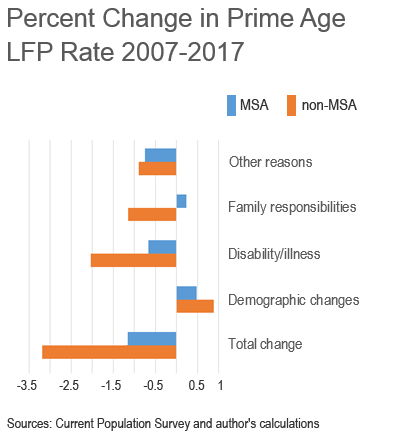A recent research study![]() by Alison Weingarden
by Alison Weingarden![]() at the Federal Reserve's Board of Governors found that wages for relatively low-skilled workers in nonmetropolitan areas of the country have been growing more rapidly than those in metropolitan areas. In a talk yesterday in Montgomery, Alabama, Atlanta Fed President Raphael Bostic provided some evidence that differences in labor supply resulting from disability and illness may be behind this shrinking urban wage premium.
at the Federal Reserve's Board of Governors found that wages for relatively low-skilled workers in nonmetropolitan areas of the country have been growing more rapidly than those in metropolitan areas. In a talk yesterday in Montgomery, Alabama, Atlanta Fed President Raphael Bostic provided some evidence that differences in labor supply resulting from disability and illness may be behind this shrinking urban wage premium.
For prime-age workers (those between 25 and 54 years old), the dynamics of labor force participation (LFP) differ widely between metropolitan and nonmetropolitan areas. (These data![]() define a metropolitan statistical area, or MSA). The LFP rate in MSAs declined by about 1.1 percentage points between 2007 and 2017 versus a 3.3 percentage point decline in non-MSA areas.
define a metropolitan statistical area, or MSA). The LFP rate in MSAs declined by about 1.1 percentage points between 2007 and 2017 versus a 3.3 percentage point decline in non-MSA areas.
The disparity is also evident within education groups. For those without a college degree, the MSA LFP rate is down 2.6 percentage points, versus 5.0 percentage points in non-MSAs. For those with a college degree, the MSA LFP rate is down 0.7 percentage points, versus a decline of 2.5 percentage points for college graduates in non-MSAs. Moreover, although LFP rates in MSAs have shown signs of recovery in the last couple of years, this is not happening in non-MSAs.
A recent macroblog post by my colleague Ellyn Terry and the Atlanta Fed's updated Labor Force Dynamics web page have shown that the decline in prime-age LFP is partly a story of nonparticipation resulting from a rise in health and disability problems that limit the ability to work. This rise is occurring even as the population is gradually becoming more educated. (Better health outcomes generally accompany increased educational attainment.)
The following chart explores the role of disability/illness in explaining the relatively larger decline in non-MSA LFP. It breaks the cumulative change in the LFP rates since 2007 into the part attributable to demographic trends and the part attributable to behavioral or cyclical changes within demographic groups.

The demographic changes—and especially the increased share of the population with a college degree—has put mild upward pressure on the prime-age LFP rate for both the MSA and non-MSA population. Controlling for the contribution from these demographic trends, increased nonparticipation because of poor health and disability pulled down the LFP rate in MSAs by 0.8 percentage points and lowered the rate in non-MSAs by 2.0 percentage points over the past decade. For those without a college degree, disability/illness accounted for about 1.2 percentage points of the 2.6 percentage point decline in the MSA participation rate, and it accounted for 2.6 percentage points of the 5.0 percentage point decline in the non-MSA participation rate.
Taken together with evidence from business surveys and anecdotal reports about hiring difficulties, it appears that the non-MSA labor market is relatively tight. The greater inward shift of the rural supply of labor is showing through to wage costs, and especially for rural jobs that require less education.
Although the move to higher wages is welcome news for those with a job, it also raises troubling questions about why labor force nonparticipation because of disability and illness has increased so much in the first place—especially among those with less education living in nonmetropolitan areas of the country.
It is clear that the health problems for rural communities have been intensifying![]() . Several interrelated factors have likely contributed to this worsening trend, including poverty, deeply rooted cultural and social norms, and the characteristics of rural jobs, as well as geographic barriers and shortages of healthcare providers that have limited access to care
. Several interrelated factors have likely contributed to this worsening trend, including poverty, deeply rooted cultural and social norms, and the characteristics of rural jobs, as well as geographic barriers and shortages of healthcare providers that have limited access to care![]() . This complex set of circumstances suggests that finding effective solutions could prove difficult.
. This complex set of circumstances suggests that finding effective solutions could prove difficult.



